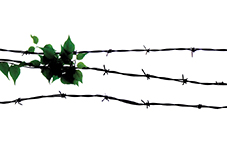Why are some people more resilient than others—and can it be taught?
By Lorna Collier
November 2016, Vol 47, No. 10
Print version: page 48

As Kay Wilson struggled to make her way through a Jerusalem forest after being repeatedly stabbed by a Palestinian terrorist, she distracted herself from her agony by playing the song “Somewhere Over the Rainbow” in her mind, composing a new piano arrangement while she fought for breath and forced herself to put one bare foot in front of the other.
Wilson, then 46, had been working as a tour guide when, on Dec. 18, 2010, she and a friend were ambushed by terrorists. Wilson witnessed her friend’s murder and was herself viciously stabbed with a machete, ultimately playing dead as her attacker plunged his knife into her chest a final time.
She eventually recovered from her severe physical wounds and is healing from her psychological trauma. She now speaks to global audiences about her survival, hoping to “dispel hatred, whether toward Arabs or Jews.”
The work “helps me make meaning out of something so senseless,” says Wilson, who is also writing a book about her experiences.
After the attack, Wilson had flashbacks and deep survivor’s guilt. But like many people who have survived trauma, she has found positive change as well—a new appreciation for life, a newfound sense of personal strength and a new focus on helping others.
Post-traumatic growth (PTG) is a theory that explains this kind of transformation following trauma. It was developed by psychologists Richard Tedeschi, PhD, and Lawrence Calhoun, PhD, in the mid-1990s, and holds that people who endure psychological struggle following adversity can often see positive growth afterward.
“People develop new understandings of themselves, the world they live in, how to relate to other people, the kind of future they might have and a better understanding of how to live life,” says Tedeschi.
How can clinicians use PTG theory to help patients? How has new research helped refine understanding of it? Here’s a look at developments in the field.
Signs of post-traumatic growth
PTG can be confused with resilience, but the two are different constructs (see “The post-traumatic growth inventory” below).
“PTG is sometimes considered synonymous with resilience because becoming more resilient as a result of struggle with trauma can be an example of PTG—but PTG is different from resilience, says Kanako Taku, PhD, associate professor of psychology at Oakland University, who has both researched PTG and experienced it as a survivor of the 1995 Kobe earthquake in Japan.
“Resiliency is the personal attribute or ability to bounce back,” says Taku. PTG, on the other hand, refers to what can happen when someone who has difficulty bouncing back experiences a traumatic event that challenges his or her core beliefs, endures psychological struggle (even a mental illness such as post-traumatic stress disorder), and then ultimately finds a sense of personal growth. It’s a process that “takes a lot of time, energy and struggle,” Taku says.
Someone who is already resilient when trauma occurs won’t experience PTG because a resilient person isn’t rocked to the core by an event and doesn’t have to seek a new belief system, explains Tedeschi. Less resilient people, on the other hand, may go through distress and confusion as they try to understand why this terrible thing happened to them and what it means for their world view.
To evaluate whether and to what extent someone has achieved growth after a trauma, psychologists use a variety of self-report scales. One that was developed by Tedeschi and Calhoun is the Post-Traumatic Growth Inventory (PTGI) (Journal of Traumatic Stress, 1996). It looks for positive responses in five areas:
- Appreciation of life.
- Relationships with others.
- New possibilities in life.
- Personal strength.
- Spiritual change.
The scale is being revised to add new items that will expand the “spiritual change” domain, says Tedeschi. This is being done “to incorporate more existential themes that should resonate with those who are more secular” as well as reflect cross-cultural differences in perceptions of spirituality.
A predisposition for growth?
How many people experience PTG? Tedeschi prefers not to put a hard number on it.
“It all depends on the trauma, the circumstances, the timing of the measurement … [and] on how you define growth using the PTGI, looking at total score, means, factors or individual items,” he says. However, he estimates that about one-half to two-thirds of people show PTG.
Some PTG researchers have tried to corroborate self-reported growth by questioning friends and family members about whether growth “sticks.”
“We are getting more studies that show that PTG is generally stable over time, with a few people showing increases and a few showing decreases,” Tedeschi says. “It is now up to us to learn what is going on with those who change over time, but the evidence is for stability in general, and also corroboration by others.”

There appear to be two traits that make some more likely to experience PTG, says Tedeschi: openness to experience and extraversion. That’s because people who are more open are more likely to reconsider their belief systems, says Tedeschi, and extroverts are more likely to be more active in response to trauma and seek out connections with others.
Women also tend to report more growth than men, says Tedeschi, but the difference is relatively small.
Age also can be a factor, with children under 8 less likely to have the cognitive capacity to experience PTG, while those in late adolescence and early adulthood—who may already be trying to determine their world view—are more open to the type of change that such growth reflects, says Tedeschi.
There also may be genetic underpinnings for PTG, but researchers are just beginning to tease this out. In a 2014 study in the Journal of Affective Disorders, for example, Harvard social and psychiatric epidemiologist Erin Dunn, ScD, and a team of researchers examined data previously collected from over 200 Hurricane Katrina survivors and found that variants in the gene RGS2 significantly interacted with levels of exposure to the hurricane to predict PTG. RGS2 is linked to fear-related disorders, such as post-traumatic stress disorder, panic disorder and anxiety.
Dunn calls the results “very interesting” but notes that “we have to be somewhat cautious in interpreting it because we were unable to find a similar sample to replicate that finding.”
Sarah Lowe, PhD, of Montclair State University, who worked with Dunn on the research, says one difficulty with gene studies for PTG is the concept’s complexity. “If you look at what predicts PTG, it is often psychological stress and dysfunction—but also more positive personality traits like optimism and future orientation, which you’d expect would have a very different genetic basis,” she says.
Theory into practice
Is it possible to prepare people for PTG, to pave the way should tragedy or trauma strike? Yes, says Tedeschi, noting that psychologists can “allow people to understand that this may be a possibility for themselves” and is a “fairly normal process” if and when trauma occurs.
More often, though, therapists will become involved not before adversity has occurred, but afterward. In this context, they can introduce PTG concepts but need to take care doing so.
H’Sien Hayward, PhD, cautions that therapists should not “jump right into the possibility of growth,” which she says can “often be construed as minimizing someone’s pain and suffering and minimizing the impact of the loss.”
Hayward, who works with veterans at VA Long Beach Medical Center in Long Beach, California, knows about such growth firsthand: She was paralyzed in a car accident when she was 16, ending a competitive athletic career. She overcame that trauma through the help of supportive family and friends, went on to study social psychology at Harvard and has traveled to more than 42 countries, often on humanitarian missions providing counseling and other support to trauma victims. Today, she credits the accident for increasing her strength of character “exponentially” by forcing her to overcome challenges. She also appreciates life and relationships with others—including the near-daily support in the small tasks of daily living that she gets from friends and strangers alike: “those interactions warm my heart.”
Yet Hayward is careful not to preach the potential for upside to her patients before they are ready. Instead, she waits for them to express “some positive reaction to the event.”
She also helps patients discover what’s meaningful in their lives and then helps them schedule activities involving these interests, such as spending more time with family members or doing volunteer work.
Tedeschi says sometimes traditional therapy for trauma patients gives people short-fix solutions to help them resume daily functions, such as sleep or work, but may not provide them with a way of living “beyond just getting by …. We’ve got to attend to their experience of life and how meaningful, satisfied and fulfilling it is.”
One veterans’ care facility that takes a nontraditional, PTG approach to trauma treatment is Boulder Crest Retreat in Bluemont, Virginia. The private, donor-supported institute provides free, weeklong nonclinical exercises and activities for vets seeking recovery from combat stress. The treatment is led primarily by veterans who have themselves gone through trauma and achieved growth. Vets are encouraged to deal with past traumas while also discovering their underlying strengths, as well as forging connections with others and ultimately finding ways to give back.
After the intensive program, vets are followed for 18 months with regular Skype check-ins.
Kevin Sakaki, a former Marine and intelligence/special operations veteran, entered Boulder Crest’s Warrior program last September and found it transformative. He’s noticed such changes in himself as better communication with his family, less anger (“Things don’t get to me as much”), a deeper appreciation of “the little things,” more generosity and a stronger connection to other people.
Tedeschi is among the psychologists studying the Boulder Crest program’s efficacy as part of a research grant funded by the Marcus Foundation.
He hopes that as vets go through the process at Boulder Crest, they “develop new principles for living that involve altruistic behavior, having a mission in life and purpose that goes beyond oneself, so that trauma is transformed into something that’s useful not only for oneself but for others.”
For further references go to our digital edition to connect directly to the research cited in this article: www.apa.org/monitor/digital.
The post-traumatic growth inventory
To evaluate whether and to what extent someone has achieved growth after a trauma, psychologists look for positive responses in five areas.
1: Appreciation of life
2: Relationships with others
3: New possibilities in life
4: Personal strength
5: Spiritual change
Source: Richard Tedeschi, PhD, and Lawrence Calhoun, PhD, Journal of Traumatic Stress, 1996

